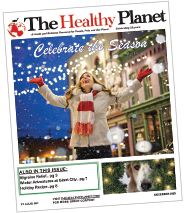
Article courtesy of the Clean Air Partnership
Scientific evidence continues to reinforce what many communities are experiencing firsthand: climate change is making it increasingly difficult to protect public health. While these threats pose serious long-term concerns, their effects are already evident today. Rising global temperatures and unpredictable weather patterns are fueling higher levels of air pollution — particularly ozone air pollution — leading to more frequent and severe unhealthy air days.
According to the American Lung Association’s 2025 “State of the Air” report, more than 125 million people — about 37% of the U.S. population — were exposed to unhealthy levels of ozone pollution during the years 2021–2023. This worsening trend is largely fueled by climate-related conditions like extreme heat, droughts and wildfires. Together, these factors are not only driving up pollution levels but also making it harder for cities and states to reduce emissions and meet clean air goals.
Here in the St. Louis region, ozone pollution remains a persistent challenge. Several days this summer have been classified as “yellow” (moderate), which poses concerns for those with respiratory issues or heightened sensitivity to polluted air. The region has also experienced at least one “orange” day, when air quality is considered unhealthy for sensitive groups and potentially the general public. In recent years, wildfire smoke drifting from Canada and the West Coast has triggered some of the worst air quality events on record, impacting cities nationwide, including New York, Chicago and St. Louis.
While everyone is affected by poor air quality, certain groups are especially vulnerable. Children, older adults, people with asthma or other lung conditions, pregnant individuals, and those who work or exercise outdoors face a higher risk of serious health impacts. For these individuals in particular, it’s important to monitor daily air quality and take precautions when pollution levels are elevated.
To help keep residents informed and safe, the Clean Air Partnership issues daily, color-coded air quality forecasts during the summer months. These forecasts provide a clear snapshot of what the air will be like the next day and offer guidance on whether people should limit outdoor activity. With the ozone season in full swing, these updates are an essential resource for helping the public reduce exposure and minimize health risks.
Additionally, our “No Red Day” campaign with Citizens for Modern Transit is running through the end of August, encouraging individuals to ride MetroLink and MetroBus to get to school, work, appointments, sporting events, entertainment venues and everywhere else they need to go. The goal is to help reduce emissions and prevent a red air quality day from happening in the region. Area residents can still visit NoRedDay.com to register for a FREE Metro Adventure Day Pass (a $5 value), which provides unlimited rides on the transit system for a day of their choice.
For more information, visit CleanAir-StLouis.com, like us on Facebook or follow @gatewaycleanair on X.


